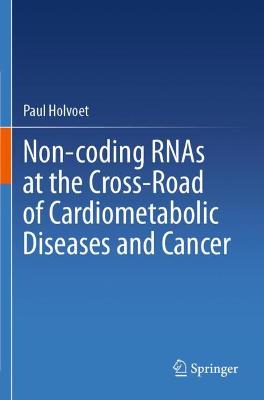(To see other currencies, click on price)
MORE ABOUT THIS BOOK
Main description:
This book gives insight into the functional role of non-coding RNAs in central pathways contributing to the development of obesity, type 2 diabetes, non-alcoholic fatty liver disease, atherosclerosis, myocardial infarction, cardiomyopathy, and heart failure. It also sheds light on the relationship of this cluster with cancer. Tumor cells, in contrast to cells in cardiometabolic tissues, can regulate this cluster of non-coding RNAs to escape from oxidative stress and anti-tumor immunity and maintain insulin sensitivity, facilitating cancer progression. The book presents a cluster of non-coding RNAs that may be prospectively analyzed in extensive cohort studies to determine their value in risk-predicting machine learning algorithms. In addition, it emphasizes the role of microvesicles in communication between tumor-adjacent tissue, inflammatory cells, and tumor cells, with a special focus on the role of miR-155.
The book intends to promote interdisciplinary research. Due to the comprehensive background information provided in each chapter, it is suitable for researchers in academia and industry and for graduate students in biology, bioengineering, and medicine.
Contents:
INTRODUCTIONThe move towards cellular risk markers
Why non-coding RNA?
Objectives
Approach
Take home message
About the author
CHAPTER I: BIOGENESIS AND MODES OF ACTION OF MIRS AND CIRCULAR AND LONG NON-CODING RNAS
1.1 MiRs
1.1.1 Biogenesis of miRs
1.1.2 MiR modes of action
1.1.3 Naming of miRs
1.1.4 Useful resources on miRs
1.2 Circular RNAs
1.2.1 Biogenesis of circular RNAs
1.2.2 Circular RNAs modes of action
1.2.3 Useful resources on circ-RNAs
1.3 LncRNAs
1.3.1 Biogenesis of lncRNAs
1.3.2 Modes of Action of lncRNAs
1.2.3 Useful resources on lncRNAs
CHAPTER II: OBESITY, INSULIN RESISTANCE IN ADIPOSE TISSUE AND THERMOGENESIS
2.1 Mechanisms in white adipogenesis
2.1.1 Role of non-coding RNA in white adipogenesis
2.2 Inflammation and insulin resistance in obese white adipose tissue
2.2.1 Role of non-coding RNA in inflammation and insulin resistance in obese white adipose tissue
2.3 Mechanisms in brown adipogenesis and thermogenesis
2.3.1 Role of non-coding RNA in brown adipogenesis and thermogenesis
2.4 Mechanisms in browning of white adipose tissues
2.4.1 Role of non-coding RNAs in browning of white adipose tissue
CHAPTER III: TYPE 2 DIABETES AND NON-ALCOHOLIC FATTY LIVER DISEASE
3.1 Mechanisms in cell maturation
3.1.1 Non-coding RNA related to cell maturation
3.2 Mechanisms in insulin signaling in the pancreas
3.2.1 Non-coding RNAs in insulin signaling in type 2 diabetes
3.3 Inflammation in the pancreas, insulin resistance, and type 2 diabetes
3.3.1 Non-coding RNA related to inflammation in the pancreas, with insulin resistance and type 2 diabetes
3.4 Non-alcoholic fatty liver disease with obesity and type 2 diabetes
3.4.1 Non-coding RNA related to non-alcoholic fatty liver disease
CHAPTER IV: ATHEROSCLEROSIS
4.1 Endothelial injury, inflammation, and apoptosis
4.1.1 Non-coding RNAs in endothelial injury, inflammation, and apoptosis
4.2 Fibroproliferative remodeling and plaque destabilization
4.2.1 Non-coding RNA in fibroproliferative remodeling and plaque destabilization
CHAPTER V: CARDIOMYOPATHY AND HEART FAILURE
5.1 Mechanisms in cardiomyopathy and heart failure
5.2 Non-coding RNAs in cardiomyopathy and heart failure
5.2.1 Non-coding RNAs in cardiac hypertrophy
5.2.2 Non-coding RNAs in cardiac fibrosis and ECM deposition
5.2.3 Non-coding RNAs in cardiac inflammation
5.2.4 Non-coding RNAs in cardiac angiogenesis
5.2.5 Non-coding RNAs in cardiac apoptosis
5.3 Metabolic syndrome: the link between metabolic and cardiovascular diseases.
5.3.1 Definition of metabolic syndrome
5.3.2 Oxidative stress and metabolic syndrome
5.3.3 Metabolic syndrome and cardiovascular risk
5.3.4 Non-coding RNAs and metabolic syndrome components
CHAPTER VI: CANCER
6.1 Mechanisms of cancer progression
6.1.1 Induction of stemness
6.1.2 Induction of EMT
6.1.3 Induction of insulin sensitized state, cancer cell proliferation, and protection against apoptosis
6.1.4 Induction of glycolysis and repression of OXPHOS
6.1.5 Induction of angiogenesis
6.1.6 Repression of anti-tumor immunity
6.1.7 EGFR signaling and cancer progression
6.1.8 BMI1 and EZH2 in cancer progression
6.2 Non-coding RNAs related to metabolic and cardiovascular diseases are also involved in cancer progression
6.2.1 Non-coding RNAs and stemness
6.2.1 Non-coding RNAs and EMT
6.2.3 Non-coding RNAs and insulin sensitized state, cancer cell proliferation, and protection against apoptosis
6.2.3. a Non-coding RNAs and insulin sensitized state
6.2.3.b Non-coding RNAs and cancer cell proliferation
6.2.3.c Non-coding RNAs and cancer cell apoptosis
6.2.4 Non-coding RNAs and glycolysis
6.2.5 Non-coding RNAs and angiogenesis
6.2.6 Non-coding RNAs and anti-tumor immunity
6.2.7 Non-coding RNAs and EGFR signaling
6.2.8 Non-coding RNAs and BMI1 and EZH2
6.3 Comparison of the role of non-coding RNAs in cardiometabolic diseases and cancer 224
6.3.1 MiRs
6.3.2 LncRNAs
6.3.3 Circ-RNAs
6.4 Differences in miR-profiles in cardiometabolic tissues and tumors may be due to the typical action of lncRNAs and circ-RNAs in tumors
CHAPTER VII: COMMUNICATION BETWEEN TUMOR-ADJACENT TISSUES AND TUMORS WITH EMPHASIS ON ROLE OF INFLAMMATORY CELLS
7.2 Exchange of miR-enriched microvesicles
7.3 MiR-155 as a link between M1 macrophage-mediated inflammation in tumor-adjacent tissue and tumor growth and metastasis
GENERAL CONCLUSIONS AND FUTURE PERSPECTIVES
Identification of non-coding RNAs at cross-road of metabolic and cardiovascular diseases and metabolic diseases and cancer
Technical developments underlying the use of non-coding RNAs as biomarker
The need for measuring fluctuation of non-coding RNAs
PRODUCT DETAILS
Publisher: Springer (Springer Nature Switzerland AG)
Publication date: March, 2022
Pages: 265
Weight: 456g
Availability: Available
Subcategories: General Issues, Genetics, Oncology

